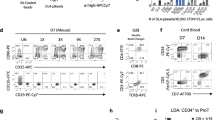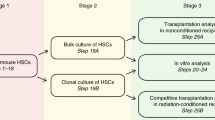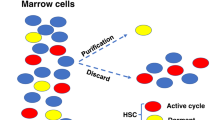Abstract
Purging of tumor cells and selection of stem cells are key technologies for enabling stem cell transplantation and stem cell gene therapy. Here we report a strategy for cell selection based on physical properties of the cells. Exposing cells to an external pulsed electric field (PEF) increases the natural potential difference across the cell membrane until a critical threshold is reached and pore formation occurs, resulting in fatal perturbation of cell physiology. Attaining this threshold is a function of the applied field intensity and cell size, with larger cells porated at lower field intensities than smaller cells. Since hematopoietic stem cells are smaller than other hematopoietic cells and tumor cells, we found that exposure of peripheral blood mononuclear cells (PBMCs) to PEFs caused stepwise elimination of monocytes without affecting the function of smaller lymphocyte populations. Mobilized peripheral blood exposed to PEFs was enriched for CD34+/CD38− cells and stem cell function was preserved. Furthermore, PEF treatment was able to selectively purge blood preparations of tumor cells and eradicate transplantable tumor.
This is a preview of subscription content, access via your institution
Access options
Subscribe to this journal
Receive 12 print issues and online access
$209.00 per year
only $17.42 per issue
Buy this article
- Purchase on Springer Link
- Instant access to full article PDF
Prices may be subject to local taxes which are calculated during checkout






Similar content being viewed by others
References
Ross A.A. et al. Detection and viability of tumor cells in peripheral blood stem cell collections from breast cancer patients using immunocytochemical and clonogenic assay techniques. Blood 82, 2605–2610 (1993).
Cote, R.J. et al. Prediction of early relapse in patients with operable breast cancer by detection of occult bone marrow micrometastasis. J. Clin. Oncol. 9, 1749–1759 (1991).
Diel, I.J. et al. Detection of tumor cells in bone marrow of patients with primary breast cancer: a prognostic factor for distant metastasis. J. Clin. Oncol. 10, 1534–1539 (1992).
Anderson, I.C. et al. Elimination of malignant clonogenic breast cancer cells from human bone marrow. Cancer Res. 49, 4659–4664 (1989).
Tondini, C. et al. Evaluation of monoclonal antibody DF3 conjugated with ricin as a specific immunotoxin for in vitro purging of human bone marrow. Cancer Res. 50, 1170–1175 (1990).
Shpall, E.J. et al. Immunomagnetic purging of breast cancer from bone marrow for autologous transplantation. Bone Marrow Transplant. 7, 145–151 (1991).
Shpall, E.J. et al. 4-Hydroperoxy-cyclophosphamide purging of breast cancer from the mononuclear cell fraction of bone marrow in patients receiving high-dose chemotherapy and autologous marrow support: a phase I trial. J. Clin. Oncol. 9, 85–93 (1991).
Myklebust, A.T. et al. Comparison of two antibody-based methods for elimination of breast cancer cells from human bone marrow. Cancer Res. 54, 209–214 (1994).
Passos-Coelho, J. et al. Bone marrow micrometastases in chemotherapy-responsive advanced breast cancer: effect of ex vivo purging with 4-hydroperoxycyclophosphamide. Cancer Res. 54, 2366–2371 (1994).
Cheng, L. et al. Selective transgene expression for detection and elimination of contaminating carcinoma cells in hematopoietic stem cell sources. J. Clin. Invest. 98, 2539–2548 (1996).
Teoh, G. et al. Adenovirus vector-based purging of multiple myeloma cells. Blood 92, 4591–4601 (1998).
Berardi, A.C., Wang, A., Levine, J.D., Lopez, P. & Scadden, D.T. Functional isolation and characterization of human hematopoietic stem cells. Science 267, 104–108 (1995).
Radley, J.M., Ellis, S., Palatsides, M., Williams, B. & Bertoncello, I. Ultrastructure of primitive hematopoietic stem cells isolated using probes of functional status. Exp. Hematol. 27, 365–369 (1999).
Lanzkron, S.M., Collector, M.I. & Sharkis, S.J. Hematopoietic stem cell tracking in vivo: a comparison of short-term and long-term repopulating cells. Blood 93, 1916–1921 (1999).
Garrett, T.J., Gee, T.S., Lieberman, P.H., McKenzie, S. & Clarkson, B.D. The role of bone marrow aspiration and biopsy in detecting marrow involvement by nonhematologic malignancies. Cancer 38, 2401–2403 (1976).
Singh, G., Krause, J.R. & Brietfeld, V. Bone marrow examination: for metastatic tumor: aspirate and biopsy. Cancer 40, 2317–2321 (1977).
Coulson, C.A. Electricity. (Oliver and Boyd, London; 1951).
Sale, A.J.H. & Hamilton, W.A. Effects of high electric fields on microorganisms: III. Lysis of erythrocytes and protoplasts. Biochim. Biophys. Acta. 163, 37–43 (1968).
Hulsheger, H., Potel, J. & Niemann, E.G. Killing of bacteria with electric pulses of high field strength. Radiat. Environ. Biophys. 20, 53–65 (1981).
Kinosita, J.K. & Tsong, T. Voltage-induced pore formation and hemolysis of human erythrocytes. Biochim. Biophys. Acta. 471, 227–242 (1977).
Sixou, S. & Teissie, J. Specific electropermeabilization of leucocytes in a blood sample and application to large volumes of cells. Biochim. Biophys. Acta. 1028, 154–160 (1990).
El-Mashak, E.M. & Tsong, T.Y. Ion selectivity of temperature-induced and electric field induced pores in dipalmitoylphosphatidylcholine. Biochemistry 24, 2284–2288 (1985).
Sutherland, H.J., Lansdorp, P.M., Henkelman, D.H., Eaves, A.C. & Eaves, C.J. Functional characterization of individual human hematopoietic stem cells cultured at limiting dilution on supportive marrow stromal layers. Proc. Natl. Acad. Sci. USA 87, 3584–3588 (1990).
Bertolini, F. et al. “Stem cell candidates” purified by liquid culture in the presence of steel factor, IL-3, and 5FU are strictly stroma-dependent and have myeloid, and megakaryocytic potential. Exp. Hematol. 25, 350–356 (1997).
Abkowitz, J.L., Catlin, S.N. & Guttorp, P. Evidence that hematopoiesis may be a stochastic process in vivo. Nat. Med. 2, 190–7 (1996).
Mauch, P., Ferrara, J. & Hellman, S. Stem cell self-renewal considerations in bone marrow transplantation. Bone Marrow Transplant. 4, 601–607 (1989).
Bradford, G.B., Williams, B., Rossi, R. & Bertoncello, I. Quiescence, cycling and turnover in the primitive hematopoietic stem cell compartment. Exp. Hematol. 25, 445–453 (1997).
Gothot, A., Pyatt, R., McMahel, J., Rice, S. & Srour, E.F. Assessment of proliferative and colony-forming capacity after successive in vitro divisions of single human CD34+ cells initially isolated in G0. Exp. Hematol. 26, 562–570 (1998).
Jacob, J., Fulghum, S. & Manning, H. New discharge pumping method for CO2 lasers. Final report. U.S. Army Missile Command Contract No. DASH01-88-C-0138. (Defense Advanced Research Projects Agency, Department of Defense, Defense Small Business Innovation Research Program (1990).
Holman, J.P. Heat transfer. (McGraw-Hill Book Co., New York, NY; 1981).
Sutherland H.J., Eaves, C.J., Eaves, A.C., Dragowska, W. & Lansdorp, P.M. Characterization and partial purification of human marrow cells capable of initiating long-term hematopoiesis in vitro. Blood 74, 1563–1570 (1989).
Acknowledgements
The authors thank Dr. Dwight Dustin and Mr. Nick Montanarelli, Ballistic Missile Defense Organization, Department of Defense; The National Technology Transfer Center, Alexandria, VA; Booz-Allen & Hamilton, Arlington, VA; the Richard Saltonstall Charitable Foundation (to D.T.S.), and the National Institutes of Health (DK50234, HL55718 to D.T.S., CA7936401 to S.R.L.). We also thank Ms. Mercedes Dekker and Ms. Ellen Kornell for assistance with manuscript preparation and Dr. Richard Evans for figure preparation.
Author information
Authors and Affiliations
Corresponding author
Rights and permissions
About this article
Cite this article
Eppich, H., Foxall, R., Gaynor, K. et al. Pulsed electric fields for selection of hematopoietic cells and depletion of tumor cell contaminants. Nat Biotechnol 18, 882–887 (2000). https://doi.org/10.1038/78504
Received:
Accepted:
Issue Date:
DOI: https://doi.org/10.1038/78504
This article is cited by
-
Mathematical Modelling of Pulsatile Blood Flow in Straight Rigid Artery System
Transactions of the Indian National Academy of Engineering (2022)
-
Targeted cellular ablation based on the morphology of malignant cells
Scientific Reports (2015)
-
A novel potent Fas agonist for selective depletion of tumor cells in hematopoietic transplants
Blood Cancer Journal (2011)
-
Electroporation of Cell Membranes: The Fundamental Effects of Pulsed Electric Fields in Food Processing
Food Engineering Reviews (2010)
-
Genetic modification of hematopoietic stem cells with nonviral systems: past progress and future prospects
Gene Therapy (2005)



